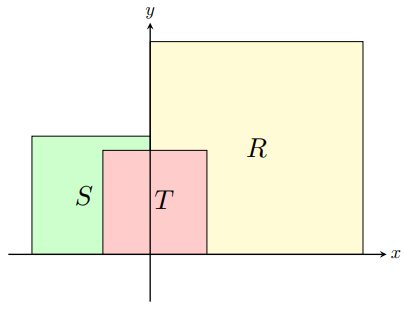Difference between revisions of "2022 AMC 10A Problems/Problem 25"
Mathboy282 (talk | contribs) (Created page with "==Problem 25== Let <math>R</math>, <math>S</math>, and <math>T</math> be squares that have vertices at lattice points (i.e., points whose coordinates are both integers) in th...") |
Mathboy282 (talk | contribs) (→Problem 25) |
||
| Line 8: | Line 8: | ||
<math>\textbf{(A) }336\qquad\textbf{(B) }337\qquad\textbf{(C) }338\qquad\textbf{(D) }339\qquad\textbf{(E) }340</math> | <math>\textbf{(A) }336\qquad\textbf{(B) }337\qquad\textbf{(C) }338\qquad\textbf{(D) }339\qquad\textbf{(E) }340</math> | ||
| − | |||
| − | |||
==Solution== | ==Solution== | ||
Revision as of 14:38, 12 November 2022
Problem 25
Let ![]() ,
, ![]() , and
, and ![]() be squares that have vertices at lattice points (i.e., points whose coordinates are both integers) in the coordinate plane, together with their interiors. The bottom edge of each square is on the x-axis. The left edge of
be squares that have vertices at lattice points (i.e., points whose coordinates are both integers) in the coordinate plane, together with their interiors. The bottom edge of each square is on the x-axis. The left edge of ![]() and the right edge of
and the right edge of ![]() are on the
are on the ![]() -axis, and
-axis, and ![]() contains
contains ![]() as many lattice points as does
as many lattice points as does ![]() . The top two vertices of
. The top two vertices of ![]() are in
are in ![]() , and
, and ![]() contains
contains ![]() of the lattice points contained in
of the lattice points contained in ![]() . See the figure (not drawn to scale).
. See the figure (not drawn to scale).
The fraction of lattice points in ![]() that are in
that are in ![]() is 27 times the fraction of lattice points in
is 27 times the fraction of lattice points in ![]() that are in
that are in ![]() . What is the minimum possible value of the edge length of
. What is the minimum possible value of the edge length of ![]() plus the edge length of
plus the edge length of ![]() plus the edge length of
plus the edge length of ![]() ?
?
![]()










